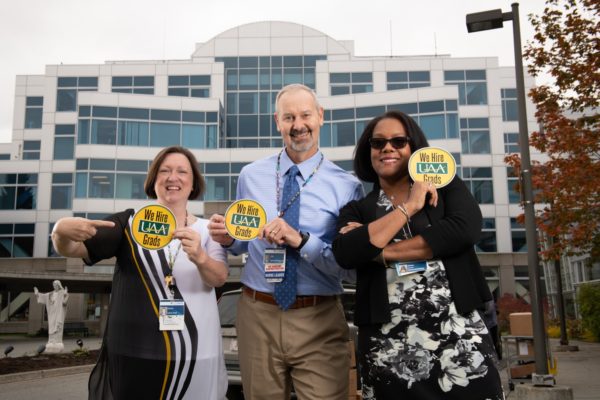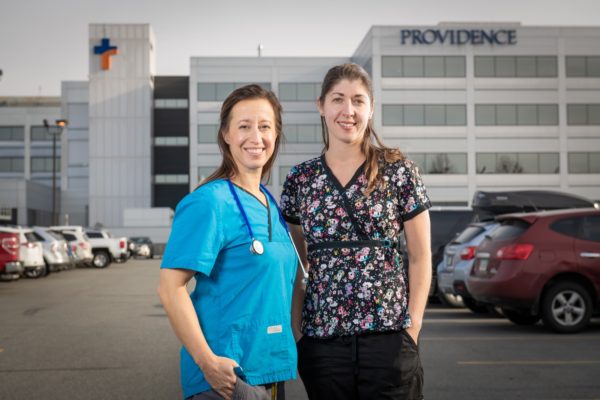Looking down the road
by Matt Jardin |

From left: Providence Alaska Medical Center director of clinical practice, research, and staff development Carrie Doyle; chief nursing executive James Reineke; and human resources director Karen Turner, B.A. '95. (Photo by James Evans / University of Alaska Anchorage)
How integral is Providence Health & Services (PHS) to Alaska? Not only does Providence Alaska Medical Center (PAMC) make up the second half of the namesake UMED District - the area both UAA and the hospital call home - but the wider PHS organization is the largest non-government employer in the state.
That status naturally results in the employment of a large number of UAA nursing alumni. For the organization, the decision to hire UAA grads is easy. Hiring managers found local hires are already invested in the community and familiar with the demands of working in remote Alaska, which can be surprising to those who move from the Lower 48.
"It allows us to be a good community partner," said journalism and public communications alumna Karen Turner, B.A. '95, human resources director for PAMC. "UAA graduates them and we scoop them up, and they stay instead of taking that knowledge out of state. It's a win-win."
The jump from UAA to PAMC is also as easy as crossing the street. By the time students graduate, they're familiar with the trip since a key component of the curriculum are clinicals - on-site training supervised by seasoned nurses. Clinicals have the added benefit as functioning as semi-interviews, which can make it easier for students to return to PAMC after graduation.
"Nationally, new nursing grads leave on average 50% of the time within the first year because what you're taught versus reality can be difficult," said Carrie Doyle, director of clinical practice, research and staff development for PAMC. "Residencies help with that transition. That's why we like to see UAA students back here. They find out about the residencies available to them after graduation, and we hire them right in because we've already become familiar with them."

From left: Providence Children's Hospital UAA nursing alums, pediatric ICU RN Carrie Berg, B.S. '00, and pediatric RN Jennifer Minsch, A.A. '06, B.S. '15, CT1 '04. (Photo by James Evans / University of Alaska Anchorage)
Similarly, it's just as easy for hospital staff to visit the university, and many do, crossing the street to influence the next batch of nursing professionals by serving as adjunct professors or guest speakers.
"The educational partnership we have gives our nurses the opportunity to stay engaged as either preceptors or adjunct faculty, so it gives us a really good connection back to the university, and helps us elevate not just the new grads who come from UAA, but the rest of our staff as well. I think that's a really positive thing for us," said Jim Reineke, chief nursing executive for PAMC and regional chief nursing officer for PHS.
Moreover, PHS leadership and the university maintain a strong partnership when it comes to shaping academic programs that are needed in the health care field. This partnership not only ensures graduates have the necessary skills to succeed in health care, but also proves to be an investment for PHS, as they'll know they have a pool of qualified applicants from which to hire.
"It's an exciting partnership in regards to workforce development," said Reineke. "What will health care look like over the next decade and what programs don't exist today but need to be there? We work together to see what's coming, where the gaps are and how we can fill that."
"We want to be on the forefront," added Turner. "So we have to look at least 10 years down the road across the whole enterprise and across Alaska and think really clearly about what things are going to look like in the future, because the status quo is not going to cut it."
More recently, that partnership resulted in the creation of UAA's surgical technology program, the success of which will hopefully provide a blueprint for the development of a similarly successful behavioral health technician program in the near future.
"We identified a hard-to-fill position and had the resources and the knowledge to get the program started," described Doyle. "Working with UAA, they had the space and the bandwidth to take on that program. Surgical tech is now about 2 years old and at a 100% pass rate, and I think we've hired the majority."
Written by Matt Jardin, UAA Office of University Advancement
Student Stories
Research
Events and Highlights
Alumni
In the News
Awards
Community
COVID-19
Diversity, Equity, and Inclusion









